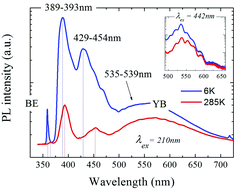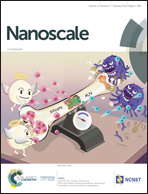Localization and transient emission properties in InGaN/GaN quantum wells of different polarities within core–shell nanorods
Abstract
Transient photoluminescence (PL) characteristics and localization phenomena in InGaN/GaN core–shell nanorods (NRs) were investigated from 6 K up to 285 K. The NRs exhibit three well-defined PL bands in the near-UV, blue, and green range ascribed to the emission of quantum well (QW) areas situated at the (1.00) sidewalls, (10.1) top facets, and (00.1) tip, respectively. At low temperature, time-resolved PL shows a fast decay time of about 0.5 ns for the semi- and non-polar QWs, while the polar QWs exhibit at least a twice-longer time. Rapid delocalization of carriers above 50 K indicates shallow potential fluctuations in the QWs. At room temperature, the characteristic fast PL decay time of the three QW bands stabilizes around 300 ps. The slow decaying PL components have different characteristic decay times that are explained by additional localization at basal stacking faults (BSFs), taking into account the quantum confined Stark effect. In addition, narrow excitonic luminescence lines are observed in the BSF-enriched polar QWs, providing direct evidence of the impact of the BSF/QW crossings on the optical properties of the NRs. A PL rise time of about 100 ps does not show any deviation between bands. These findings are suggestive of similar transport mechanisms in temperature equilibrium without inter-facet transport between different QWs. We believe that predictable transient characteristics can play a key role in creating uniform NR ensembles for device applications.



 Please wait while we load your content...
Please wait while we load your content...